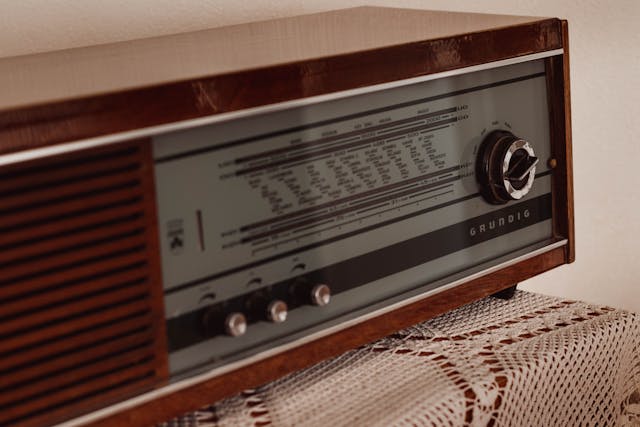
What is the difference between AM and FM radio? The radio waves are moderated differently. AM radio waves are Amplitude Modulated and FM radio waves are Frequency Modulated.
First, we need to look at how a radio broadcasts a signal. The radio has three jobs. It has to take the voice or music that is put into it and convert that into an electrical signal. It has to modulate that signal to fit it to a radio wave. Then it has to transmit that radio wave. On the other end, the receiver has to do three things as well. The receiver has to pick up the specific radio wave from all of the thousands of radio waves floating in the sky. It has to remove the electrical information that was modulated onto the radio wave. Then it has to amplify that signal and play it through the speakers. How does it do it?
The first step is to turn the sound into an electrical signal. There are different ways of doing it, but if you use a mic then the mic can convert sound energy into electrical energy. When we speak, we are creating pressure waves with our sound. The microphone has a diaphragm that vibrates when the pressure wave hits it. This vibration moves a magnet inside a coil and that motion creates an electrical current that varies on the strength of the vibration.
The second step is to modulate that electrical signal so that it can be carried on a radio wave. This is done in two parts. First, the radio transmitter has to create a radio wave. It does this with electrons. The electrons move up and down the carrier wave generator very fast. Each time they move up and down they create a magnetic field and an electric field. This is the radio wave. The number of times the electrons move up and down is the frequency of the wave. If they move up and down 600,000 times a second, then that wave has a frequency of 600,000 Hertz, or 600 kHz. This radio wave will travel out of the radio transmitter at the speed of light. The radio wave is known as the carrier wave because it will carry the sound information. The electrical signal that our mic has made for us has to be connected to this radio wave so it can be carried. The electrical signal from our mic is not very strong and wouldn’t travel very far. The carrier wave is very strong and will travel very far. To attach the sound signal to the carrier wave, the carrier wave has to be modulated. And this is where AM and FM come in.
A radio wave has an amplitude and a frequency. The amplitude is the height of the wave above its center line. If you think about the sea, the amplitude would be the height of each wave above sea level. The frequency of a wave is the number of waves that pass a certain point every second. If you think about the sea again, if the wind is strong, more waves will go past you in a second than if the wind is not strong. That is high frequency vs low frequency. To add the recorded sound’s electrical signal, you can modify the radio wave. You start with a carrier wave of a specific frequency and amplitude. Then, you can either modify its amplitude, or you can modify its frequency. If you modulate its amplitude, that is AM radio. The electrical signals are added to the wave. They will make the wave either higher or lower, depending on the sound. If you modulate the frequency, it is FM radio. The sound signal is added to the carrier wave and in some places it is much faster and in some places, it is much slower.
The last thing the radio transmitter has to do is transmit the signal and this is the easy part because those carrier radio waves just want to fly through the sky at the speed of light.
Now, we come to the receiver, which is your radio. It has an antenna, which is a big piece of metal. Its only job is to stick up into the sky and try to intercept as many radio waves as possible. It catches lots of radio waves, but you only need the one that is carrying your radio station. You tune the radio in to the specific frequency of the carrier wave, if it is FM radio, or the specific amplitude of the carrier wave if it is AM radio. The radio goes down the aerial into the radio and into the demodulator. The demodulator’s job is to strip away the carrier wave, leaving the electrical signal that is the sound. It can do this because it knows the specific amplitude or frequency of the carrier wave because you set it. Once the carrier wave is gone, everything that is left is the sound and all the radio has to do is amplify that and play it through the speakers.
Both AM and FM are good for radio, but they do have some differences. AM can travel much further than FM can. It also takes up less bandwidth, so you can have more stations in a range of frequency. FM has a higher bandwidth, which means there can be fewer stations, but the higher bandwidth means that it has better quality. AM is much easier to detect, and AM radios are cheaper to make. However, AM can be affected by electricity in the atmosphere, other radio waves, and noise, making it less clear. FM has better quality, but the high frequency means that it is deflected by tall buildings. AM’s lower frequency lets it pass through buildings. And this is what I learned today.
https://www.diffen.com/difference/AM_vs_FM
Sources
https://www.explainthatstuff.com/radio.html
https://en.wikipedia.org/wiki/Hertz
https://electronics.howstuffworks.com/radio.htm
https://www.pbs.org/wgbh/aso/tryit/radio/indext.html
https://www.britannica.com/technology/electromechanical-transducer
